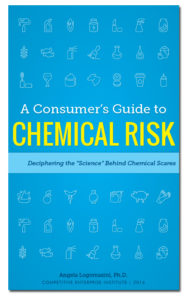Activist groups are pushing government regulations and programs at all levels to limit an even ban numerous industrial chemicals. These campaigns also include listing chemicals on “concern lists” without scientific justification as well as “voluntary” initiatives to reduce “hazardous” products.
The crux of the problem is the focus on “hazard” rather than likely risks. “Hazard” simply represents the potential for danger given specific circumstances and/or exposures. For example, water is hazardous because excessive consumption can produce fatal “water intoxification” or hyponatraemia. But we don’t need to regulate it or place it on a “concern list.”
Likewise, we have many “hazardous” products in our homes—everything from cleaning supplies to bug spray to olive oil (which can make you slip if spilled on the floor). Each can be a hazard, but the risk depends on how we use them. Fortunately, we can benefit from each of these products while managing the risks to keep them low.
Yet bureaucrats at the U.S. Environmental Protection Agency (EPA) are developing a list of “chemicals-of-concern” based largely on the hazardous quality of chemicals. That way, they don’t have to demonstrate that the chemicals actually pose real concerns—enough to justify regulations under the nation’s chemical law, the Toxic Substances Control Act (TSCA).
TSCA’s reasonable risk standard holds the agency accountable. It allows EPA to regulate only when the agency can demonstrate that a chemical possess an “unreasonable risk of injury to health or the environment.” It also demands that regulators weigh the risks of the chemical against the risks of the regulatory action. After all, shouldn’t we demand that regulations don’t do more harm than good?
The bureaucrats would like to change the law to gain what amounts to arbitrary and unaccountable regulatory powers, but they have thus far failed. Accordingly, they apparently have decided to demonize products without passing any regulations—pushing valuable chemicals off the market by giving their targets a bum rap.
Indeed at a presentation at a chemical industry conference—the 2012 GlobalChem Conference—EPA’S representative Jim Jones basically explained that industry needs to come to terms and negotiate with greens on a bill—or else. If they don’t, he explained, EPA would continue to list their products and make them vulnerable in the marketplace.
The agency’s Design for the Environment (DfE) provides another example of EPA’s strong-arm tactics. The program calls on companies to eliminate certain chemicals from their products voluntarily, largely based on hazard rather than actual risk.
The agency is using the DfE program to strong-arm the laundry industry, for example, to stop using detergents that include a certain class of chemicals—Nonylphenol Ethoxylate (NPE) surfactants–although there has been no proper risk assessment process that would justify regulations under TSCA. Meanwhile, the producers of these chemicals are up in arms as they see their market disappear without justification or due process.
The trade association representing these chemical makers and some users—the Alkylphenols & Ethoxylates Research Council—complained about this effort in press statement. It noted that EPA’s review of the issue under the DfE program “represents at best a simplistic hazard-based review that will not ensure that products formulated with the alternative surfactants will be safer or pose a lesser risk to human health or the environment.”
Yet EPA can get away without proper reviews and standards because, after all, the program is “voluntary!”
DfE falls within what the agency dubs its “green chemistry” mission—a concept that several states have latched onto as well. California was early to act, passing a law all the way back in 1986, which mandated product labeling based on the “hazardous” chemicals they might contain. As a result, perfectly safe products bear scary labels about the “hazards” allegedly lurking within. Rather than educate people and provide useful information, such programs needlessly instill fear.
Now California—like EPA—is working to give such “hazard-based” policies more teeth, with its 2009-passed “green chemistry initiative,” for which regulations are now under development.
Still some people say we should regulate hazards to be on the “safe side” as embodied in a concept called the precautionary principle. But this is nonsense because it warrants regulations of basically everything!
It is worth noting, that even risk-based regulation can prove excessively precautionary. In fact, most of the highly precautionary laws and regulations currently on the books include some form of risk assessment that error on the side of caution, building in a host of safety factors that substantially overestimate exposure to justify regulatory actions that may not be necessary.
Such random elimination of technologies—via government strong-arm tactics or actual regulations – wastes the human ingenuity and investment that went into make those goods and denies society the benefits. Often additional resources then innovators must divert resources from new enterprises to finding substitute products, which may pose new risks. The final result is not a safer world, but a poorer, potentially more dangerous one.
Browse the terms on the sidebar of this webpage for more details and/or download a copy of A Consumer’s Guide to Chemical Risk: Deciphering the “Science” Behind Chemical Scares.


